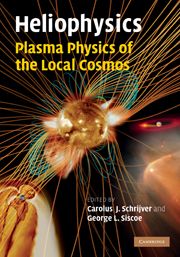Book contents
- Frontmatter
- Contents
- Preface
- 1 Prologue
- 2 Introduction to heliophysics
- 3 Creation and destruction of magnetic field
- 4 Magnetic field topology
- 5 Magnetic reconnection
- 6 Structures of the magnetic field
- 7 Turbulence in space plasmas
- 8 The solar atmosphere
- 9 Stellar winds and magnetic fields
- 10 Fundamentals of planetary magnetospheres
- 11 Solar-wind– magnetosphere coupling: an MHD perspective
- 12 On the ionosphere and chromosphere
- 13 Comparative planetary environments
- Appendix I Authors and editors
- List of illustrations
- List of tables
- References
- Index
13 - Comparative planetary environments
Published online by Cambridge University Press: 05 August 2013
- Frontmatter
- Contents
- Preface
- 1 Prologue
- 2 Introduction to heliophysics
- 3 Creation and destruction of magnetic field
- 4 Magnetic field topology
- 5 Magnetic reconnection
- 6 Structures of the magnetic field
- 7 Turbulence in space plasmas
- 8 The solar atmosphere
- 9 Stellar winds and magnetic fields
- 10 Fundamentals of planetary magnetospheres
- 11 Solar-wind– magnetosphere coupling: an MHD perspective
- 12 On the ionosphere and chromosphere
- 13 Comparative planetary environments
- Appendix I Authors and editors
- List of illustrations
- List of tables
- References
- Index
Summary
Introduction
The nature of the interaction between a planetary object and the surrounding plasma depends on the properties of both the object and the plasma flow in which it is embedded. A planet with a significant internal magnetic field forms a magnetosphere that extends the planet's influence beyond its surface or cloud tops. A planetary object without a significant internal dynamo can interact with any surrounding plasma via currents induced in an electrically conducting ionosphere.
All the solar system planets are embedded in the wind that streams radially away from the Sun. The flow speed of the solar wind exceeds the speed of the fastest wave mode that can propagate in the interplanetary plasma. The interaction of the supersonic solar wind with a planetary magnetic field (either generated by an internal dynamo or induced externally) produces a bow shock upstream of the planet. Objects such as the Earth's Moon that have no appreciable atmosphere and a low-conductivity surface have minimal electrodynamic interaction with the surrounding plasma and just absorb the impinging solar wind with no upstream shock. Interactions between planetary satellites and magnetospheric plasmas are as varied as the moons themselves: Ganymede's significant dynamo produces a mini-magnetosphere within the giant magnetosphere of Jupiter; the electrodynamic interactions of magnetospheric plasma flowing past the atmospheres of volcanically active Io (Jupiter) and Enceladus (Saturn) generate substantial currents and supply more plasma to the system; moons without significant atmospheres (e.g. Callisto at Jupiter) absorb the impinging plasma.
- Type
- Chapter
- Information
- Heliophysics: Plasma Physics of the Local Cosmos , pp. 360 - 398Publisher: Cambridge University PressPrint publication year: 2009
- 9
- Cited by



